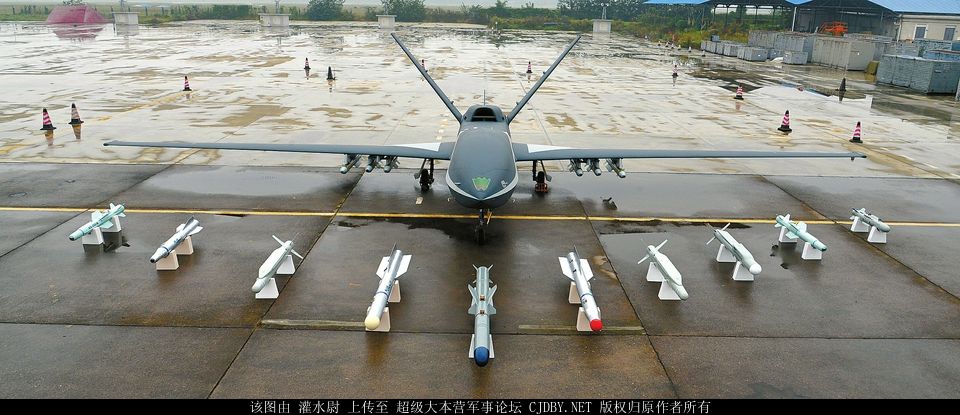

China’s military drone industry, already one of the world’s largest, is on full display at the Zhuhai 2016 Airshow. The airshow has featured some of China’s high tech attack and surveillance drones for the first time, as well as provided glimpses of the future, with stealthy UAVs, ‘marsupial drones’, supersonic robot planes, and drone swarms.

One of the most prominent on display is the Cloud Shadow. An export version of Sky Wing, it is a semi-stealthy drone roughly the size of the US-made MQ-9 Reaper. Its stealthy features include a jet engine hidden from enemy radar by a serpentine air intake, serrated panel edges, canted vertical stabilizers, as well as a faceted nose. While it lacks an internal weapons bay, its six hardpoints can carry a combined payload of 400 kg, including a wide range of sophisticated precision-guided munitions like the YJ-9E light cruise missile, FT-7 satellite guided glide bomb, and anti-tank missiles. Additionally, it can take on electronic intelligence gathering missions.
While the Cloud Shadow may not be stealthy or fast enough to survive long in high tech conventional combat, its suite of long-range weapons and stealthy features, as well as low cost, make it a good fit for hybrid warfare against non-state actors and a likely future buy for many other states.

Another massive Chinese UCAV is the CH-5, with a wingspan of 21 meters and a massive payload of one ton of weapons and sensors. Other mission modules include jammers for electronic warfare, and airborne early warning radars to detect enemy aircraft and drones. Chief designer Shi Wen notes that the CH-5 has a flight time of 60 hours, with a 6,500 km range (future upgrades include increasing the range to 10,000km and 20,000km and a flight time of 120 hours). Even more interesting, the CH-5’s programming and datalink allows its controllers to link up with other UCAVs, like the CH-3 and CH-4, to conduct joint, multi-drone missions.

CH-805 Stealth Target Drone, is a 4-meter wingspan flying wing drone that can fly high subsonic speeds. Its RCS of 0.01 square meters indicates its role as a target for simulating stealth aircraft to Chinese fighters and air defense missiles. However, its high flight performance would make it a good candidate for potential modification into an operational use, such as a ‘wingman’ drone for Chinese fighters and bombers.

CK-20 is a supersonic target drone concept in the advanced stages of development. A 5.5-ton, single-engine aircraft roughly the size of a jet fighter trainer, it can fly at an altitude of 18 km, reach speeds of up to Mach 1.8. It may make first flight around 2020, and like the CH-805, has stealthy features, including canted vertical stabilizers. Similarly, its high speed could make it a candidate to be developed into an operational role.

Unmanned/manned “centaur” combinations between Chinese manned systems and drones would reduce the risk to Chinese pilots by allowing unmanned systems to take on more dangerous roles. The SW-6 is another AVIC UAV that fits into this approach. While it has twin folding wings and a weight of around 30-50 pounds, it is a “marsupial” drone that can be attached to the hard points of helicopters like the Z-11WB, riding along until releases like a missile or bomb. A helicopter (or other aircraft, even a large drone) could carry, deploy and operate multiple SW-6s to scout ahead and around for targets or hazards like enemy air defenses (and in a pinch, crash the SW-6 onto a soft target).

CH-500 is a small co-axial rotary UCAV weighing around 100 kg-200 kg. Its dual rotor arrangement eliminates the need for a tail rotor, thus making its small size even more compact. CH-500 can carry two HJ-10 anti-tank missiles. Its small size makes this robot helicopter suitable for use by smaller formations like battalions and companies, giving frontline Chinese commanders ready and responsive access to airstrikes.

Finally, Zhuhai 2016 provided a big taste of the future in the form of a drone swarm. CETC partnered with Tsinghua University to build a swarm of at least a couple dozen drones, which were shown flying in formation, and then going into improvised, network-generated flight patterns, marked by interdrone communications and coordination to reach their destination. The video then showed the drone swarm conduct a wide area search of their surroundings. While the CETC-Tsinghua drone swarm is unarmed, a CGI sequence showed the drones hunting an enemy missile launcher in urban area, and then explosively dive-bombing into the missile launcher, destroying it.
You may also be interested in:
China’s Armed Robot Helicopter Takes Flight
Chinese Drones Make Key Breakthrough, Firing on Command by Satellite
For Sale: The Next Generation of Chinese War Robots
China Has a New Armed Drone Helicopter
The Military Applications of China’s CES Passenger Drone
Iraq’s New Chinese Drone Draws First Blood
